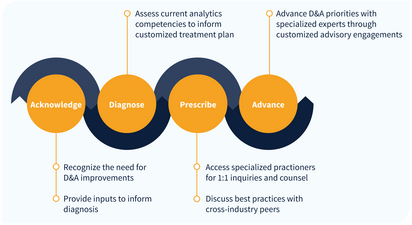Client Inquiry:
As our analytics team shifts from a centralized, project-based model to a federated, program-based approach, we’re facing two key challenges. First, we’re struggling with how to allocate limited resources to both enterprise priorities and day-to-day business requests. Second, as we enable segments to become more self-service, we need to reimagine how we’ll support them going forward—especially when those requests aren’t formally funded.
Expert Takeaways:
Frame Work Around Utility, Enabler, and Driver
The first step in effective resource planning is to create a shared vocabulary that distinguishes between different types of work. One useful model divides analytics activities into three categories:
- Utility work is foundational: recurring reporting, dashboard tweaks, and minor data enhancements. These requests tend to be urgent, unglamorous, and often underfunded—but they’re critical for keeping the business running.
- Enabler work supports business decision-making and improvement. This might include building new data products, diagnostic investigations, or predictive models. Enabler projects typically offer clear ROI and are often the focus of segment-level funding.
- Driver work involves innovation and transformation. These are moonshot initiatives—experiments in GenAI, new business models, or next-gen data applications. They’re risky by design and require distinct funding strategies.
Without this framework, utility work often gets deprioritized in favor of visible, ROI-driven projects. The result? A growing backlog of unfunded but essential work that slows progress elsewhere.
Rethink Funding and Intake Processes
Resource allocation challenges are rarely solved by headcount alone. They’re shaped by how work enters the system and how it's funded.
- The team’s current funding is a mix of cost center budget, project-specific funding from business units, and allocations tied to enterprise portfolio initiatives. That patchwork creates uncertainty—and makes unfunded utility work the first to fall through the cracks.
- Intake reform is already underway: a new prioritization framework scores requests based on business value, and the team has moved from complex forms to a conversational model supported by office hours. That shift is helping surface the real context behind each request.
- Still, more clarity is needed around funding expectations. Business units understand they must fund enabler projects. But when those projects transition to maintenance mode—when they become utilities—the funding often disappears.
- Consider value-based strategies. If a model saves a segment $5 million, allocate a portion (say, $500K) back to analytics to support ongoing work. Or at minimum, tie resource growth to the number of projects launched that require future support—just as infrastructure and compute costs scale with usage.
Lay the Groundwork for Federation Now
Leadership has made clear that the future is federated—and that the centralized team will retain ownership of enterprise-level analytics while enabling partner segments to drive their own insights. That transition requires planning beyond structure.
- If enabler work continues to dominate, and utility work continues to be underfunded, the only sustainable solution is to accelerate the move to federation.
- Partner segments must begin to own the long-term cost of the projects they initiate. That means embedding post-launch support into the business case, even if the funding structure isn’t fully in place today.
- Federated models work best when there’s a clear delineation of responsibility: enterprise teams govern standards and infrastructure, while segment teams own their own priorities, including utility maintenance.
- Use analogies that resonate: if cloud storage and compute costs are forecasted and budgeted, so too should the incremental utility cost of analytics projects.
- Where pushback is likely, enlist leadership support. Mirror IT’s model for ongoing maintenance funding. Or build margin into your work as a pseudo-internal consultancy—if you deliver value, ask for a share of it to sustain your team.
Expert Network
IIA provides guided access to our network of over 150 analytics thought leaders, practitioners, executives, data scientists, data engineers with curated, facilitated 1-on-1 interactions.
- Tailored support to address YOUR specific initiatives, projects and problems
- High-touch onboarding to curate 1-on-1 access to most relevant experts
- On-demand inquiry support
- Plan validation and ongoing guidance to advance analytics priority outcomes
- Monthly roundtables facilitated by IIA experts on the latest analytics trends and developments
